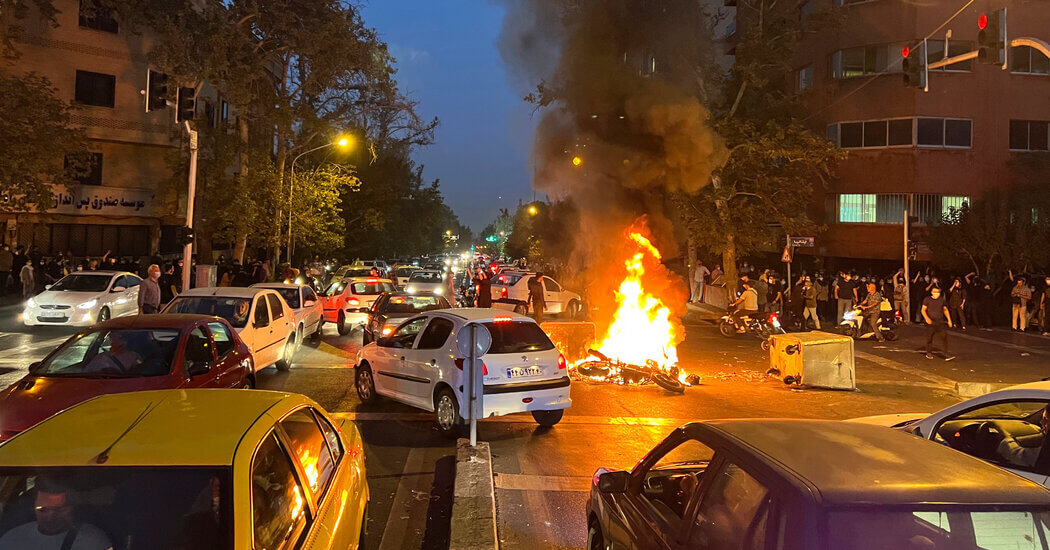The death of a 22-year-old Kurdish woman in the custody of Iran’s morality police days after she was arrested for failing to cover her hair modestly has sparked one of the biggest anti-government movements in the country since 1979. Crucially, it has also sparked debate on the survivability of the regime, given existing concerns about human rights and economic mismanagement. Adding more fuel to the fire, the Iranian leadership has dismissed the protests as a foreign conspiracy and unleashed the full force of its security apparatus. At the time of writing this article, almost 80 protesters have been killed in clashes with security forces since the demonstrations began on 16 September.
While the immediate trigger for the protests was Mahsa Amini’s death, the demonstrations have expanded into a larger movement demanding an end to theocratic rule. A defining feature of the protests, which are rapidly spreading across Iran, has been the willingness of mostly young Iranians to openly challenge the regime and call for its demise. Protesters have also wished death upon ageing Supreme Leader Ayatollah Ali Khamenei, in power for over four decades.
Therefore, the ongoing movement is a protest against Iran’s religious leadership and its refusal to embrace change in over four decades in power. At the heart of the problem is the very nature of the regime—a hardline theocracy.
In 1979, immediately following the ouster of the Shah, Mohammad Reza Pahlavi, the clerical establishment took over power. Rather than ushering in the democracy that Iranians had been demanding, the clerics, led by Ayatollah Ruhollah Khomeini, declared Iran as an Islamic republic based on the tenets of Shi’ism. Since then, Tehran has imposed religious strictures that have impacted almost all aspects of daily lives, particularly those of women.
According to the Sharia-based legal structure, women must mandatorily wear the hijab in public places or face punishment. Women are prevented from attending public events along with men, most notably in the case of football matches. Moreover, the law makes it extremely difficult for women to get divorced from their husbands. Furthermore, child marriage is heavily prevalent, with the legal age of marriage for girls set at 13. Simultaneously, homosexuality is punishable by death and the constitution favours Muslims over non-Muslims.
Religion has also permeated Iranian politics, which revolves around the will of the supreme leader. This has prevented Iran from achieving a truly democratic polity, despite conducting regular parliamentary and presidential elections. For instance, the supreme leader plays a huge part in selecting the president. All presidential candidates are vetted by the 12-member Guardian Council, of which six members are directly appointed by the Khamenei and the other six are proposed by the chief of the judiciary, who is also appointed by the supreme leader. This gives Iran’s highest authority the power to both choose and eliminate political candidates at will. The most recent example of this was the 2021 presidential election, when, shortly before the polls, the Guardian Council barred several reformist candidates from participating.
Democracy, then, is what Khamenei decides and political freedom is an illusion created by the clerical establishment. Any sort of opposition to the system is severely suppressed by the regime through the use of loyal paramilitaries, wherein protesters and activists are routinely jailed or tortured. Accordingly, human rights monitor Freedom House has categorised Iran as “not free” and said there are tight restrictions on freedom of speech and media freedoms. Furthermore, the constitution bans protests “detrimental to the fundamental principles of Islam,” an excuse used by the regime to crack down on protesters.
Such unrestricted power in the hands of a few means that corruption is rife. It is prevalent at the bottom of the political hierarchy as well as among the top leaders, including the president and the supreme leader. President Ebrahim Raisi, while claiming to be an anti-corruption warrior, is alleged to have diverted millions of dollars from an institution he headed for his 2017 presidential campaign. Likewise, a Reuters investigation in 2013 found that Khamenei controlled a “massive financial empire based on property seizures” worth almost $100 billion.
Taking all of this into consideration, it is not surprising that tens of thousands of people are now venting their anger against the regime. Anti-government protests have taken place in Iran throughout the 40-year history of the Islamic Republic and the regime has always emerged successful by resorting to brute force. However, the demonstrations over Amini’s death are part of a series of demonstrations against the political system, generating doubt about whether we could be at a tipping point.
In 2022 alone, there have been several protest movements relating to poor economic conditions, rising inflation levels, poor labour conditions, corruption, poor governance, and women’s rights. Similar protests have also occurred in 2019, 2020, and 2021.
This has lent to rumblings about the survivability of the Iranian regime, which has for decades seemed impermeable. Anti-government protests have not only become more frequent but also more violent. According to Iran scholar Trita Parsi, “by blocking reforms, narrowing Iran’s political spectrum, and further limiting freedoms […] the regime is literally pushing people to choose revolt over reform.” Therefore, unless Iran’s rulers express an unlikely willingness to address at least some of the protesters’ concerns, domestic discontent will continue and could ultimately culminate in a highly undesirable and seemingly unlikely downfall for the regime.
Iran’s Regime Is Scripting Its Own Downfall
Anti-government protests have not only become more frequent in the recent past but also taken a violent turn.
September 29, 2022

Protests in Tehran over Mahsa Amini's death IMAGE SOURCE: AP
